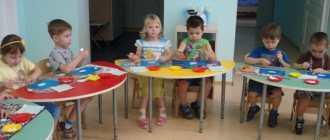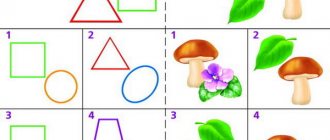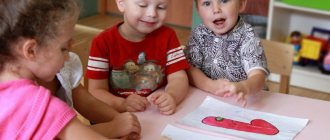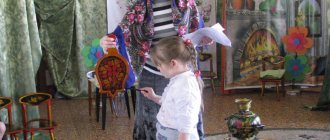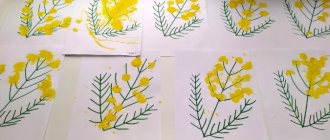In preschool age, all children love to draw; it helps them express themselves and comprehend the knowledge they have acquired about the world around them. That is why the development of creative abilities in visual arts is so effective and efficient.
For a long time, teaching drawing in childhood was considered almost exclusively as part of aesthetic education. However, at the end of the last century, psychologists finally recognized that visual activity is an important condition for the development of the child’s psyche, and not only creative abilities.
Children's development in visual arts
In the material you can see a selection of drawings by students of the author of the article, Marina Golubeva. Students made these images while doing the Draw a Sound activity. The results were very interesting drawings that illustrate how creativity and imagination come to life on paper.
Draw the sound - the sound of falling snow
The consciousness of preschool children, their thinking and worldview largely remain a mystery to teachers and psychologists. But studying the possibilities of developing creative abilities in visual activities led researchers to very interesting conclusions. It turns out that when a child is engaged in drawing, all mental processes are activated, including the development of creative thinking. But we are not talking only about this higher type of cognitive processes. The development of children in fine arts takes place in a variety of spheres and areas of the psyche.
- Drawing satisfies the most important needs of children: to communicate and understand the world, to express their emotions and relaxation.
- The development of fine motor skills of the hand in visual activities has a positive effect on all areas of the brain, activating thought processes.
- Development of visual memory: drawing not only ensures memorization and long-term preservation of images, but also stimulates their reproduction. Moreover, this happens directly, without connection with speech, which in children (and many adults) is not developed enough to convey all the details and nuances of visual images.
- The development of creative abilities in visual activity is also associated with the fact that drawing develops the skills of conscious, purposeful imagination.
- In preschool age, imaginative thinking plays an important role, and nothing develops it better than drawing.
Development of creativity in drawing – Call
The development of creative abilities in fine arts is not the only thing that determines the role of drawing in children’s lives. No less important is the fact that drawing has a huge psychotherapeutic effect. It helps kids relieve emotional stress, throw out negative emotions on paper, calm down and tune in to the positive.
Development of children's visual creativity
The relationship between visual arts and other types of children's activities in kindergarten.
The interconnection of various types of children's activities allows us to deepen and expand children's ideas about the world around them, increase their emotionally positive impact on the upbringing process, and make this process more effective. The influence on the child occurs through activities that are interesting to him.
Visual activities in kindergarten are part of all educational work with children and bear the burden of solving the problems of comprehensive education of preschoolers. The relationship between visual activities in kindergarten and other aspects of educational work with children contributes to the development of interest in drawing, modeling, appliqué, mastering the means of representation, and increasing the effectiveness of the comprehensive education of children.
Program objectives for visual activities are interconnected with the goals and objectives of other sections of the work. Solving specific problems is based on what children have learned and learned before. Work at the institution is organized according to thematic weeks. Every time children are given the opportunity to discover the world around them anew. It contains so many interesting and new things!
During the week “Insects” we consider and study the life of insects. Here's an ant crawling - the baby has never seen anything like this! And all attention is focused on the insect. You can mold it, draw it, make an applique. During the “Spring has come” week, watching the first snowdrops, the child again experiences surprise and the joy of learning. During the “Transport” week, watching with the children a bus, a crane, or a “fire” truck passing by the kindergarten, we observe the enthusiastic children’s eyes following them with their gaze.
The environment evokes positive emotions in children and a desire to talk about what they saw, what delighted and attracted their attention. And having learned the possibilities of drawing, sculpting, and appliqué, children strive to convey this fascinating world in their visual arts. The surrounding life provides ample opportunities for enriching drawings, modeling and applications with new and varied content. Children of junior and senior preschool age always find objects and themes for their images of the life around them.
Visual activities are closely related to children’s familiarization with their surroundings. It is important that the interconnection of these sections of educational work be of a natural, logically substantiated nature, not far-fetched, and that familiarity with the environment is not subordinated only to the tasks of learning to draw, sculpt, and appliqué.
The work of educators and preschool specialists within the framework of a single theme of the week and the integration of different types of activities helps the child to comprehensively become familiar, study and see a subject, object or phenomenon from different sides. Reflect your impressions and acquired knowledge in productive activities.
For example, having planned a drawing on the topic “Cars are driving along the street,” the teacher begins to introduce them to cars driving along the street, offers to look at different cars, watch them on the street, listen to an interesting story about it, and play the game “Crossroads.” Knowing about the great interest of children in cars, the teacher plans activities in which the children can reflect their impressions.
We attach special importance to the relationship between the activities of drawing, modeling, and appliqué with work on developing children’s speech and reading fiction.
We read fairy tales and stories to children, learn poems with them, and together we compose stories, riddles, poems, and fables. Children develop speech, thinking abilities, and artistic and figurative representations. When children subsequently draw, sculpt, cut out and paste images on the themes of fairy tales, stories, and poems, their imagination and desire to express their attitude to what they have learned in visual form are activated. To convey the theme of a fairy tale or poem, children must remember the content.
In order to activate speech, we invite them to explain what and how they will draw, and after finishing the work, talk about their works and the works of their comrades, evaluating them and motivating their assessment. The children enjoy the process and everyone is eager to have their say. Systematic conduct of such analysis as a result of the activity contributes to the acquisition by children of the ability to create detailed statements, and even short stories about work, while their speech is enriched, acquiring a figurative coloring due to the inclusion of epithets, figurative comparisons, poetic lines and a positive emotional attitude. Children love to draw, sculpt, and create applications based on fairy tales, stories, and poems. The proposal to create images on the themes of literary works always finds a lively, emotional response from children. The guys drew a postman from S. Ya. Marshak’s poem “Mail”, a girl with blue hair from A. N. Tolstoy’s fairy tale “The Golden Key”, Doctor Aibolit from the work of the same name by K. I. Chukovsky.
Children especially enjoy drawing covers for fairy tales. During the “Baby Books” themed week, children drew covers for fairy tale books and made book pages. This was preceded by interesting work to get acquainted with the children's book and its creation. The teachers told the children about how a children's book comes into being and who works on it (writer, editor, artist, printers, etc.).
Children's book exhibitions were organized in groups. For them, they used not only those books that were available in groups and in kindergarten, but also books brought by children and adults from home. The children carefully examined the books: how they were designed, which artist created the cover and drawings, paid attention to the features in the manner of design of books by such wonderful artists, and compared the design of the same work by different artists.
Working during the “Baby Books” week with great interest and joy, the children, together with their parents, created books with drawings based on the fairy tales “The Little Humpbacked Horse” by P. Ershov, “The Little Thumb” by C. Perrault and many others. The institution now has a whole collection of children's books with fairy tales, poems, and characters. A collection of books made by children and parents was presented at the general exhibition of the kindergarten.
We attach special importance to the relationship between drawing, modeling, and appliqué with play. Both in play and in visual activities, children reflect their impressions of the life around them. The connection between these types of children's activities is determined by the specifics of the child's visual activity, which consists in playful manifestations in the process of creating an image and in a playful attitude towards the image.
Having created an image of this or that object, an animal, the child begins to play with them: the motor of the drawn airplane begins to “hum”, and now it is already flying. The game “revitalizes” the image, and this in turn determines figurative, emotional perception, ideas about objects and phenomena of the environment, and is an indispensable condition for the development of imagination, without which artistic creativity is impossible.
Role-playing play plays a big role in children’s lives. Educationally valuable is its relationship with visual activity, which not only enriches children’s creativity with new themes, but also deepens knowledge of the surrounding reality and contributes to the development of play. In order to reflect the events of the surrounding life that have become the content of children's games, children must again, as it were, relive these events, clearly imagine and realize them.
The events experienced by the child in the game color his artistic activity with positive emotions: in his drawing he talks about what and how he played. Reflection of games in drawings, as experience shows, helps to deepen and enrich the content of games - they become long-lasting, new characters and new episodes are included in them.
Observations of children's games allow us to identify the most common plots. This is a clinic (hospital), family, pharmacy, store, firefighters, pilots, construction, school and others. Games that reflect the experiences of everyday life. The richer the children’s impressions, the more interesting and meaningful the game.
Teachers, trying to enrich the content of children's games, pay attention to expanding their horizons; this also serves to enrich the visual activities of children. The children welcome the offer to draw how they played.
Great opportunities in implementing the tasks of comprehensive education also lie in the relationship between drawing, modeling, and appliqué with dramatization games. Dramatization games are based on literary works. Carrying out such a game requires a clear representation of the image of the literary hero and the plot of the work, the ability to convey character, actions and deeds using appropriate postures, gestures, movements, voice and other means, which is impossible without imagination.
Teachers and children prepare scenery, details of character costumes, and masks for the dramatization game. The teacher's proposal to draw how the children played this or that fairy tale arouses keen interest in visual activities and helps to enrich children's drawings. Basically, dramatization games are based on fairy tales. We give preference to fairy tales with a large number of characters, so that as many children as possible can take part in them. We also take into account children’s visual abilities.
The connection between visual activities and dramatization games can be carried out from the middle group. For dramatization games we use such fairy tales as “Teremok”, “Three Bears”, The Wolf and the Seven Little Goats”, “The Hare and the Hedgehog” (based on the fairy tale of the Brothers Grimm) and others. In the process of preparing for the dramatization of these fairy tales, we think about what children could do to play in visual activities: color the animal masks cut out by the teacher (vodka, goats) or draw masks of a hare, three bears.
A game for which children have done a lot with their own hands is more lively and interesting, evokes positive emotions that unite the children with a common joy, and leaves deep impressions.
In the senior and preparatory groups, we use more complex fairy tales, with a larger number of characters, plots, and scenery.
Dramatization games are interesting from a pedagogical point of view because all children of the group can be involved in their preparation and implementation: some as role players, others as craftsmen and artists in preparing the details of costumes, masks, and scenery, and others as spectators who actively perceive the actions of the heroes. deeply emotionally experiencing all events. And then the children all draw together on how the fairy tale played out. Thematic exhibitions are decorated with children's works.
During the “Games and Toys” week, the children took with great interest the proposal to create drawings about what outdoor games they played. At the same time, we agreed with the guys that they would portray the game characters in the images of animals and birds, objects and people who are the characters in the game, and not children. The children met this proposal with great interest. The unusual nature of the task evoked a positive emotional response, and mental transformations into the image of an animal or other game character contributed to the development of figurative ideas.
Thus, when creating drawings on the theme of the game “Crucian carp and pike”, children drew the corresponding fish; depicting the game “Geese-geese” - running geese and a wolf waiting for them under the mountain. The offer to draw how the children played this or that outdoor game pleases the children, and the drawings, as a rule, turn out to be varied and expressive.
Images of objects and objects of reality, musical and literary works are conveyed in different types of artistic activity in their own way. Thanks to the means of expressiveness in drawing - this is form, line, stroke, color, proportions, composition, dynamics, rhythm; in a dramatization game - intonation, facial expressions, gestures, movements; in music - tempo, dynamic scores, rhythmic pattern.
In order to implement the relationship between visual activity and music, we use songs, instrumental program and non-program music. A song, being a synthetic form of art, includes not only music, but also an artistic word, the images of which influence the child, causing vivid, imaginative impressions and a positive emotional attitude towards them. This determines the accessibility of the song work for children.
That is why the implementation of the relationship should begin with a song. It can be used as a means of enriching children's creativity from the age of 2-3 years. Children aged 3 listened to the “Autumn Song” (music by A. Alexandrov, lyrics by N. Frenkel), and then enjoyed drawing how colorful autumn leaves swirled in the air and fell to the ground. After singing the song “Chickens” (music by A. Filippenko, lyrics by T. Volgina), the guys pasted a general picture on the theme “Chickens walking on the grass.” Songs as a means of enriching the content of children's drawings, modeling, and applications can be widely used in different age groups.
After listening to the piece, children express their impressions of the music, and then create images in accordance with these impressions. This type of relationship is interesting because it awakens imagination, gives rise to a variety of images that enrich children's visual creativity, which in turn deepens children's impressions of musical works and promotes their memorization.
The connection between visual activities and the work of introducing children to works of art is very important. By looking at paintings or reproductions, sculpture, and works of folk decorative art, children get an idea of how an artist selects objects to depict, what means he uses to convey images, and how differently a particular topic can be solved. For example, in still lifes, different artists depict the same fruits, vegetables, various foods, and dishes in different ways. The variety of creative solutions when artists create images of nature shows children the varied possibilities of art. So, during the “Games and Toys” week, the general exhibition of the kindergarten was decorated with the works of children of senior preschool age (decorative young ladies, goats, lambs...).
Acquaintance with fine arts enriches with new knowledge and ideas about the world; reveals the richness and beauty of the surrounding world; develops aesthetic perception and imagination; introduces new expressive possibilities of drawing, modeling, and appliqué; promotes the development of creativity. The relationship between different types of artistic and creative activities is based on the expressive transmission of their images and the transformation of images of one activity into another (for example, playing drawing).
In this regard, in the process of teaching visual activities in kindergarten, it is necessary to develop in children visual skills and abilities, including drawing techniques, formative movements, generalized methods of action and regulation of drawing movements (in terms of strength, range of speed). Teaching graphic skills and abilities is a means of aesthetic development: the positive emotions that a child experiences, having been able to successfully depict what he wanted, deepen aesthetic processes and feelings, and consolidate interest in the activity. Skills and abilities allow children to freely reflect objects, phenomena of the surrounding life, and the content of literary works in their drawings. Lack of skill fetters, causes negative emotions and even causes refusal of visual activity.
A detailed disclosure of the relationship between visual activity and various types of activities in educational work with children represents the integration of visual activity with all areas of education and training, ensuring an increase in children’s interest in the environment, natural phenomena and objects, various games and in the visual activity itself.
Literature:
1. Bogateeva Z.A. Preparing a child’s hand for writing in drawing classes // Preschool education. 2007. – No. 8.- P. 49-53.
2.Gorkova L.G. Integration of program sections in preschool institutions. – Voronezh, 2001.
3. Klimova E.P. Artistic and aesthetic development of preschool children. – Volgograd, 2005
4. Grigorieva G.G. Visual activity of a preschooler: textbook. manual for universities. – M.: Academy, 2009.
5. Kozlova S.A., Kulikova T.A. Preschool pedagogy. – M., 2007.
6. Matveeva A.N. Preparing your hand for writing. – M., 2004.
7. Preparing children for school in kindergarten / Ed. Sokhina F.A., Taruntaeva T.V. – M., 2008.
Development of children's creative abilities through unconventional drawing
All children are researchers; they are passionate about learning previously unknown things and mastering new activities. Therefore, it is useful to use unusual techniques and develop children’s creative abilities through unconventional drawing.
Imagination on paper - clicking heels
The use of unconventional techniques and techniques helps children overcome fear and uncertainty, because they are still poor at using a pencil and brush, and they do not always like their own drawings. And failures greatly reduce motivation and interest in drawing and make it difficult to develop creative abilities in visual arts.
There are quite a lot of methods that are considered non-traditional, and they are intended for children of different ages. So, for the little ones the following are suitable:
- Finger painting is very useful in early childhood, as it develops not only imaginative thinking, but also tactile sensitivity.
- Finishing the drawing of handprints is very exciting and develops imagination and imaginative thinking.
- Using a variety of prints, which allows kids to admire the beautiful prints.
- Blotography is an absolutely amazing technique. Children love her very much, looking with delight at the original paintings created from simple blots.
- Drawing with sand allows kids to master a completely unusual material.
How to depict Rustle - draw the sound
MAGAZINE Preschooler.RF
Features of the development of creative abilities in children of senior preschool age in visual artsPreschool age has the richest opportunities for the development of creative artistic abilities. Unfortunately, these opportunities are irreversibly lost over time, so it is necessary to use them as effectively as possible in preschool childhood.
The development of creativity is based on the formation of morality, aesthetic education, and the need of children for creative work. Without difficulty, it is impossible to form a full-fledged creative personality, to instill high moral feelings in a child.
Psychological and pedagogical research, as well as the practice of our kindergartens, prove that the beginning of the development of children's creative abilities falls on preschool age, when the nature of their activities changes compared to early childhood. This new type of activity by L.S. Vygotsky characterizes it as a transition to creative activity, “if we keep in mind the fact that in all types of activity of a preschooler, completely unique relationships of thought to action arise, namely the possibility of realizing a plan, the ability to go from thought to situation, and not from situation to thought. Whether you take drawings, whether you take work, everywhere and in everything you will deal with completely new relationships that arise between the child’s thinking and actions .
Unlike adults, children are not able to think through the upcoming work in all details; they outline only a general plan that is implemented in the process of activity. The teacher’s task is to develop the child’s creative abilities, purposeful imagination, and encourage him to move from thought to action in any activity. It is necessary to teach children to see beauty, to understand and appreciate works of art, the beauty and richness of their native nature. This will be possible only when children feel joy and satisfaction from what they have created, if the creative process puts them in a good mood.
This will be facilitated by such forms of joint activity between the teacher and children as mini-museums, in particular the museums of “Folk Art” , “Folk Crafts” , as well as “Art Galleries” , “Vernissages” . A current form of developing the creative abilities of preschoolers is familiarization with various types of art during virtual tours and excursions.
When using these methods, it is important that the teacher shows his feelings to the children, his attitude.
For example, the topic “Going to the Zoo” . To depict it creatively, you need to “go” to the zoo with your children, then have a conversation about what they saw there and what they liked most. Often, children are happy to share their emotions and impressions from a trip to the zoo, and then during an art class, creating their own works, they show creativity - sculpt, draw, etc.
It is necessary to take into account the stages of development of the creative process during children's visual activity:
- The first stage involves “nurturing a plan” - the content is being developed, the artistic form is being searched. This period can be either long or very short. All thoughts and feelings are subordinated to a specific goal, intensive work of the imagination takes place. So, for example, the same topic “Going to the Zoo” : children, at the beginning, think about what they will sculpt or draw, what material they will use, what colors they will use in their work;
- the second stage is “execution, implementation of the plan . The essence of this stage is the transformation of thought into material reality. Actually, it is the process itself. Intensive work of imagination continues, ideas are clarified, enriched and detailed. The process of depiction itself can influence the content. The idea can change and be adjusted greatly. Children sculpt or draw the animal they like best or the one they would like to portray.
- the third stage is an assessment of the result obtained and modification, if necessary. Children compare their works, try to finish drawing or filling in what, in their opinion, is missing in the work, sometimes evaluate each other’s work in order to get an assessment from strangers.
A special place in the development of children's creativity is given to the child's independent activity. Organization of conditions for independent activities of children according to their interests. In order to develop children's visual creativity, a subject-development environment is organized in groups:
- “Young Artist’s Workshop” , where various materials for art activities, books, games, stencils in an expanded assortment, etc. are presented;
- Creative corners where you can experiment with various materials: mix colors, draw with colored crayons, washable markers on various surfaces, create products from clay, plasticine, work with collage material, scissors for the right and left hands, glue, thick paper, cardboard and material for mastering various non-traditional painting techniques: finger painting, soap flakes, sponge printing, flow printing, rope printing, wax. Carrying out work with unusual materials and unconventional techniques allows children to experience unforgettable positive emotions.
There are many non-traditional drawing techniques, their unusualness lies in the fact that they help children quickly achieve the desired result. For example, what child would not be interested in drawing with his fingers, making a drawing with his own palm, putting blots on paper and getting a funny drawing. The child loves to quickly achieve results in his work.
At older preschool age, children can master even more difficult methods and techniques:
- blotography with a tube
- stencil printing
- regular blotography
Thus, the main task of the teacher is solved, which is related to the development of the interests and creative abilities of each child, stimulating the activity and independence of children. Free, varied activities in an enriched subject-development environment allow the child to show his inquisitiveness, curiosity, to learn about his surroundings at his own request, without coercion, and to strive for a creative reflection of what he knows. In the conditions of an aesthetic subject-development environment, the child realizes his right to freedom of choice of activities and manifestation of creativity.
| Next > |
